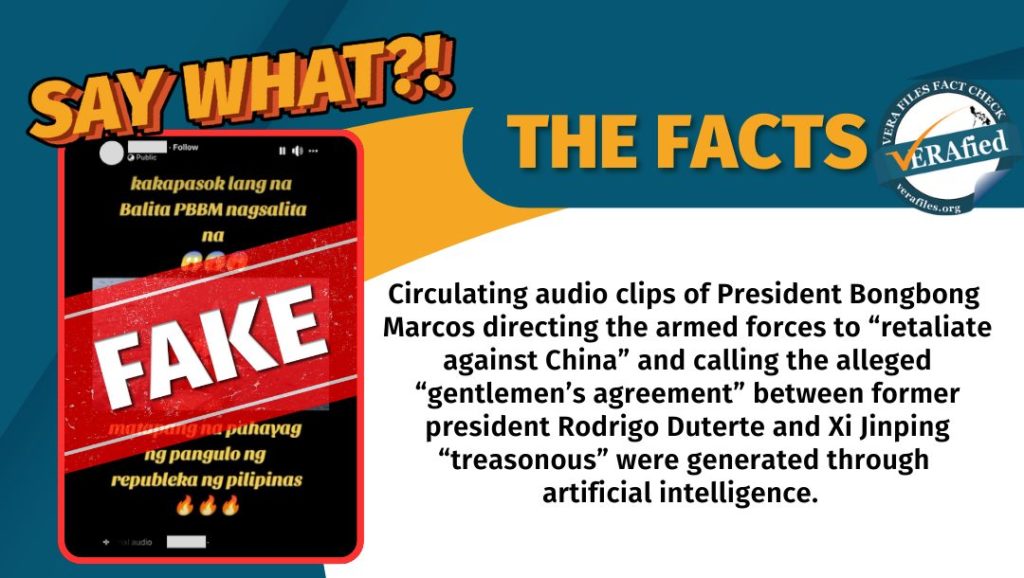A reel containing audio clips of President Ferdinand “Bongbong” Marcos supposedly directing the armed forces to “fight back” against China and calling the alleged “gentlemen’s agreement” between former president Rodrigo Duterte and Xi Jinping treason is fake. It is artificial intelligence (AI)-generated.
Posted on TikTok as early as April 20, the two-minute and 14-second video showing images related to the South China Sea dispute continues to gain traction despite a denial issued by the Presidential Communications Office. It carries this text:
“Kakapasok lang na Balita PBBM nagsalita na matapang na pahayag ng pangulo ng republeka ng pilipinas (Just in. PBBM already said something. A bold statement from the President of the Republic of the Philippines).”
It contains audio clips that sound like Marcos making pronouncements on the territorial dispute with China. In a portion of the video, Marcos can be heard saying:
“We cannot further compromise the lives of our countrymen just to protect our rightfully own sea and maritime domains. Sabi ko sa ating magigiting na sundalo, gumanti sa China kung kinakailangan. Dapat na tayong pumalag at gamitin ang ating pwersa para matigil na itong mga pambubully (I told our brave soldiers, retaliate against China if necessary. We must already stand up and use our forces to stop this bullying).”
In the same video, Marcos can be heard supposedly calling ex-president Duterte’s “gentlemen’s agreement” with China “a clear form of treason.”
“‘Yung kasunduan naman ng China with former president duterte, na tinatawag nilang gentleman’s agreement, may mga inassign na akong tao at opisyal na magsasagawa ng imbestigasyon kung ano nga ba talaga ang nangyari (As for China’s agreement with former president Duterte, which they call a gentleman’s agreement, I have assigned people who will officially conduct an investigation on what really happened). This situation must not be taken lightly. This is a clear form of treason against our motherland. Kung kailangan siyang ipatawag sa senado, ipatawag (If he must be summoned to the senate, summon him).”


The president made no such statements. The circulating clip has been denied by the Presidential Communications Office (PCO) in its April 23 advisory.
“The audio deepfake attempts to make it appear as if the President has directed our Armed Forces of the Philippines to act against a particular foreign country. No such directive exists nor has been made,” a part of their statement read.
Earlier, when asked about the alleged “gentlemen’s agreement” between Duterte and Xi Jinping, Marcos said it was “horrifying” but did not describe it as treasonous.
“I am horrified by the idea that we have compromised through a secret agreement the territory, the sovereignty and the sovereign rights of the Philippines,” the president said in an April 10 media interview.
Marcos added that he has reached out to the former administration’s officials regarding the agreement but has not received “a straight answer.”
The AI-generated clip circulated more than two weeks after Senator Risa Hontiveros filed a resolution seeking to investigate the “gentlemen’s agreement,” stressing that it would be “an act of treason” if found to be true.
According to the PCO, the Philippine National Police has already identified the possible source of the deep fake audio.
VERA Files has been monitoring and debunking AI-generated audio clips imitating various Filipino personalities. (Read AI-edited ad shows Chavit Singson promoting bogus product)
The original TikTok video containing the clips uploaded two weeks ago garnered 149,900 likes and 11,800 comments before it was taken down. The videos re-uploaded by an FB user collectively garnered 2,837 engagements. Some TikTok users have also reposted the video.
Have you seen any dubious claims, photos, memes, or online posts that you want us to verify? Fill out this reader request form or send it to VERA, the truth bot on Viber.
(Editor’s Note: VERA Files has partnered with Facebook to fight the spread of disinformation. Find out more about this partnership and our methodology.)


